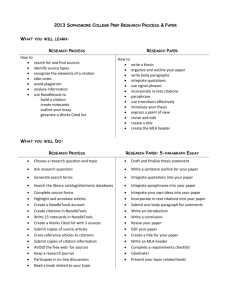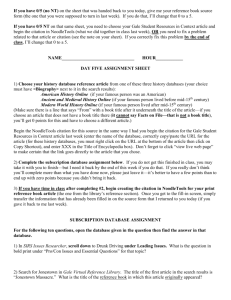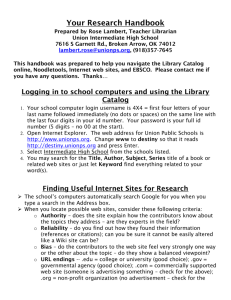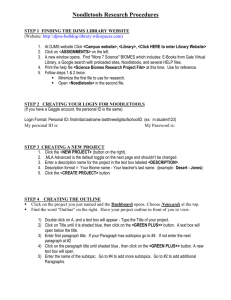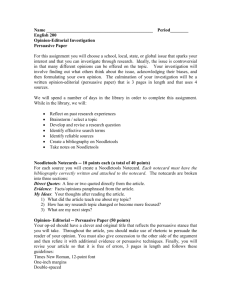Your Research Handbook
advertisement
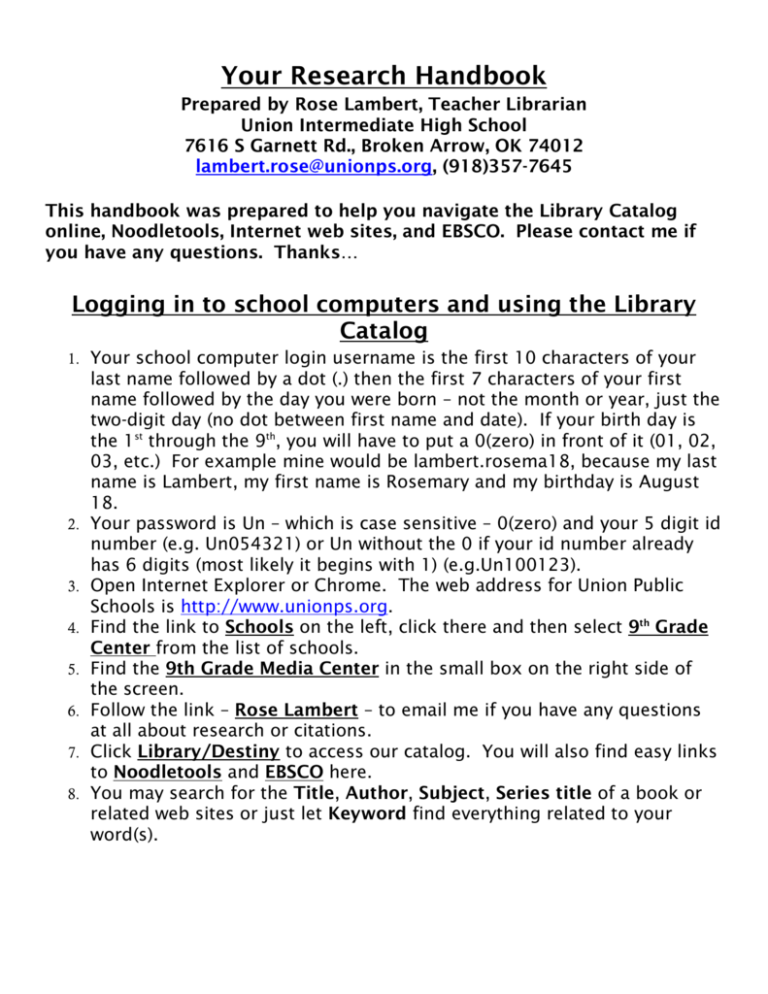
Your Research Handbook Prepared by Rose Lambert, Teacher Librarian Union Intermediate High School 7616 S Garnett Rd., Broken Arrow, OK 74012 lambert.rose@unionps.org, (918)357-7645 This handbook was prepared to help you navigate the Library Catalog online, Noodletools, Internet web sites, and EBSCO. Please contact me if you have any questions. Thanks… Logging in to school computers and using the Library Catalog 1. Your school computer login username is the first 10 characters of your 2. 3. 4. 5. 6. 7. 8. last name followed by a dot (.) then the first 7 characters of your first name followed by the day you were born – not the month or year, just the two-digit day (no dot between first name and date). If your birth day is the 1st through the 9th, you will have to put a 0(zero) in front of it (01, 02, 03, etc.) For example mine would be lambert.rosema18, because my last name is Lambert, my first name is Rosemary and my birthday is August 18. Your password is Un – which is case sensitive – 0(zero) and your 5 digit id number (e.g. Un054321) or Un without the 0 if your id number already has 6 digits (most likely it begins with 1) (e.g.Un100123). Open Internet Explorer or Chrome. The web address for Union Public Schools is http://www.unionps.org. Find the link to Schools on the left, click there and then select 9th Grade Center from the list of schools. Find the 9th Grade Media Center in the small box on the right side of the screen. Follow the link – Rose Lambert – to email me if you have any questions at all about research or citations. Click Library/Destiny to access our catalog. You will also find easy links to Noodletools and EBSCO here. You may search for the Title, Author, Subject, Series title of a book or related web sites or just let Keyword find everything related to your word(s). Finding Useful Internet Sites for Research When you locate possible web sites, consider these following criteria: o Authority – does the site explain how the contributors know about the topics they address – are they experts in the field? o Reliability – do they tell you how they found their information (references or citations); can you be sure it cannot be easily altered like a Wiki site can be; if it is a blog, has it been created by an authority in the field? o Bias – do the contributors to the web site feel very strongly one way or the other about the topic – do they show a balanced viewpoint? o URL endings -- .edu = college or university (good choice); .gov = governmental agency (good choice); .com = commercially supported web site (someone is advertising something – check for the above); .org = non-profit organization (no advertisement – check for the above); .net = networked computer like yours at home would be (no reliability at all); .k12 = Kind. – 12th grade school system (you might be reading what a 3rd grader wrote) If you want to find Ms. Lambert’s recommended websites, click the Visual Tab in the Library Catalog and use the icons to navigate to her selections. How to use EBSCO for Online Magazine and Newspaper Articles 1. Open Internet Explorer or Chrome. If it doesn’t open automatically, the web address for Union Public Schools is http://www.unionps.org. 2. Find the link to Schools on the left, click there and then select 9th Grade Center from the list of schools. 3. Find the 9th Grade Media Center in the small box on the right side of the screen. 4. Select the link to EBSCO in the middle of the page. The direct web address is search.epnet.com (be sure not to put www in this address). 5. You will have to enter a user ID and password, the User ID is union and the password is redskins. 6. When the site opens, choose School Libraries –it provides the most fulltext articles; not just links to articles you can’t actually read online. 7. When the database list opens: Check the boxes next to MAS Ultra, Newspaper Source and Academic Search Premier. Read the description of the other databases. If one or more of them might help with information for your topic, click the box next to that database. When you have selected all the databases you want, click the button which says Continue at the top or bottom of the page. 8. In the search box type keywords for a search for your topic. EBSCO searches the titles of articles and the abstract (an abbreviated version of the article) for your words, so be careful with spelling and try words you think authors might use. For example, try teen, teenage, youth or adolescent for similar articles. 9. Click on the name of any of the articles in the list to see them one at a time. Read the abstract to see if the article will give you information you can use. 10. For Linked Full Text articles and PDF Full Text articles, you will need to click on the link to that text which is on the left. 11. Arrow back and forth and try many article titles or different search words until you find something about your topic. Keep trying! 12. When you are ready to cite your article in Noodletools, click on the words Detailed Record to find your citation information. Getting Started in Noodletools 1. Open Internet Explorer or Chrome. If it doesn’t open automatically, the web address for Union Public Schools is http://www.unionps.org. 2. Find the link to Schools on the left, click there and then select 9th Grade Center from the list of schools. 3. Find the 9th Grade Media Center in the small box on the right side of the screen. 4. Click Noodletools. Or you may access Noodletools at noodletools.com. 5. Click on in the upper right corner. 6. If you used Noodletools last school year, simply sign in using your lastname.firstname or the same username you use to log in to school computers as your Personal ID and your school ID # or the same password you use to log in to school computers as your Password. Then, skip to step 10, validate your information on file and then go to step 13. 7. If you are unable to login or have not used Noodletools before, click on Create a Personal ID. 8. Leave the settings and click Register. 9. Ask the librarian for your School/Library Username and your School/Library Password. Fill those in and then, click Sign In. 10. Fill in the following: a. Expected year of graduation: choose your year from the drop down list b. Personal ID: Fill in you’re the same username you use to log in to the school computer. c. Password: The same password (based on your id #) as you use to log in to school computers d. Retype the same password. e. Initials: the first letter of your first and last names f. Phone: the last four digits of your phone number (or 0000) 11. Then, click Register. 12. On the right hand side of the screen, click . 13. When the next screen comes up, the Citation style most used in High School is MLA and the Citation level is Advanced – click in the bubbles next to those two items. And then put a title for your list in the box labeled Description. 14. Click on Create Project. 15. You will be directed to your Dashboard for this project. 16. Click the link which says Share this project with my teacher. 17. In the Assignment Drop Box, enter the assignment title which will be written on the board. 18. Then, fill in your name and click on Share Project (you should not check mark Share Google Docs) 19. Click the tab for Bibliography at the top of the screen. Then use the following “how to” pages to start adding citations for books, encyclopedias, websites and magazine and newspaper articles. To return to your project after the first time, simply sign in to Noodletools using the information you used to create your personal ID and password. Click on the name of your project and then you will be back to step 19 above. HOW TO CITE BOOKS On the Works Cited screen, select “Book” from the drop-down list where it says <Select a citation type> and then click Create Citation. 1. Explore the next screen if you wish, or click Continue. 2. Then, under the tab labeled Print you will see boxes to enter the following (the information for these are all on the front or back of the title page of the book) and are the only information you need to enter: a. Contributors(s) – this is talking about the author(s) of your book. i. Select Author from the dropdown labeled Role. ii. Type the author’s first and last names (be sure to capitalize these) into the boxes with those labels. If your author has a middle name or initial, put it in; if not leave the box blank. A suffix is Jr. or II – your author most likely doesn’t have a suffix so you may leave that blank if it’s not given. iii. To add another author, click the link that says Add another contributor. Add as many authors as you have on the title page. b. Title of the book or multivolume work: Type the title of the book – be sure to capitalize important words in the title. c. Title of volume in multivolume set (if individually titled): In most cases, you will not have a separate title for a volume of a multivolume work – so you may leave that box blank. d. Publisher: The company which published your book. This is usually found at the bottom of the front of the title page. If it is not listed there, turn and look at the back of the title page. The full address is usually listed there. e. Publication city: Use the first one in the list if more than one city is on the front of the title page. If it is not listed there, turn and look at the back of the title page. The full address is usually listed there. f. Publication year: Copyright © year (if more than one is listed, use the most recent date). Do not put “copyright” or © in the box on Noodletools. g. You don’t have to put an edition or series name if your book doesn’t have those – just leave them blank h. Annotation: you don’t put anything there unless your teacher has told you to annotate. 3. When you have filled in these citation boxes, scroll to the bottom and click Submit. HOW TO CITE ENCYCLOPEDIAS On the Works Cited screen, select “Reference Source (Dictionary, Encyclopedia, etc.)” from the drop-down list where it says <Select a citation type> and then click Create Citation. 1. Explore this screen if you wish, or click Continue. 2. Then, under the tab labeled Print you will see boxes to enter the following information a) Author(s) of the article/entry a. The author’s name will be located at the end of the article in small print or right under the title of the article. b. If no author is given, you may leave this blank. b) Article /entry title: Put the title of your article exactly as it appears in the reference book, e.g. an article about Abraham Lincoln may be shown as Lincoln, Abraham. If the articles in your reference source are in alphabetical order, please check the box which says Alphabetically arranged entries. c) Pages: starting page and ending page of the article. d) Contributors to the reference source as a whole: Fill this in if the title page of your source gives an author or editor (and choose which one he/she is in front of the names). e) Type of reference source: usually an encyclopedia. f) Title of encyclopedia: probably you will also check the box next to This is a well-known, widely-used reference work. g) Year – probably found on the outside (on the spine) of the encyclopedia. If you have to look on the back of the title page, use the most recent date listed. h) You may leave the rest of the boxes blank. i) Annotation: you don’t put anything there unless your teacher has told you to annotate. 3. When you have filled in your citation boxes, scroll to the bottom and click Submit. HOW TO CITE WEB SITES On the Works Cited screen, select “Web Site” from the drop-down list where it says <Select a citation type> and then click Create Citation. 1. Explore this screen if you wish, or click Continue. 2. Under the Web Site tab, please fill in the following: a. Most recent date of access (M,D,YYYY) — Leave this set on today’s date. b. Date of e-publication: will most likely be at the bottom of the website – if it only gives a Copyright © year, that is all you need to put in this field – NOTE: If you do not find a date for your web article, you do not need to fill this box. c. URL: This is the web address which will send your teacher to the exact webpage you used for research. Copy and paste this from your web site. d. Contributor(s): This is filled in if an author’s name is listed either at the top of text or at the very bottom. Select the role from the dropdown list also. NOTE: If you do not find a date for your web article, you do not need to fill this box. e. Web Page or document/article title: Most web sites will have many different pages/articles in them. This is very important to fill in if there is a separate article title for your information, e.g., the name of the website could be PBS and the page or article might be “Annie Oakley.” But if only one title is listed, put it in the “Name of Web site” location. f. English translation of document/article title: You will not need to translate your title – it is most likely already in English. g. Name of the Web site: This is whatever is at the top of the text of the web site you are viewing — not the web address (URL) in the address box. You must put information in this box to create a citation. h. Publisher of the site: This is the name of the organization who sponsored the website – look for this especially if you have no author. But if it is the same as the name of the website – like National Geographic, only list it once in the “Name of Web site” location. NOTE: If you do not find a date for your web article, you do not need to fill this box. i. Editors of the site as a whole: You will rarely find or need to enter this information. 3. When you have filled in your citation boxes, scroll to the bottom and click Submit. 4. After you have submitted a citation with a correct URL on Noodletools, you should be able to click View Live Webpage to the left of your citation and the web page will open again. HOW TO CITE ONLINE JOURNALS, MAGAZINE, AND NEWSPAPER ARTICLES On your EBSCO screen, click Detailed Record to find the information you will need for your citation. First, figure out what you are citing: On your Search Results screen at EBSCO, There will be a small picture with a caption next to each article choice – the ones I have seen so far are: Academic Journal (Journal), News (Newspaper), Periodical (Magazine), Reference (Reference Source). On the Works Cited screen, select “Journal,” “Magazine,” “Newspaper,” or “Reference Source (Dictionary, Encyclopedia, etc.)”from the drop-down list where it says <Select a citation type> and then click Create Citation. 1. Explore this screen if you wish, or click Continue. 2. Find the tab which says Database and click there (you are not citing a printed source here). 3. Fill in the following information: a. Name of the database --labeled Database: for you at the bottom of your EBSCO citation box -- such as Newspaper Source or MAS Ultra. Once you start typing in this box, a drop down list will appear and you can find your database in the list and click on it. b. You may skip the boxes labeled Database accession number and DOI. c. Most recent date of access (M,D,YYYY) — Leave this set on today’s date. d. URL – on the right side of the EBSCO screen, click Permalink to get the URL you must copy and paste into your citation. DO NOT use the URL in the address box above e. Article Author(s): if authors are not listed you may leave this blank. f. Article title: this is located at the top of the EBSCO screen – not labeled. g. Page numbers: this is located on the line with the Source in EBSCO – find p or pp or pg and fill in the boxes on Noodletools with the numbers given. h. Name of journal/newspaper/magazine: look for the title in blue right after Source: on your EBSCO screen. i. Publication date -- look right after the name of the magazine/newspaper (Source) for this information. If it is not there, you may leave it blank. j. Volume and issue – look right after the name of the magazine/newspaper (Source) for this information. If it is not there, you may leave it blank. 4. When you have filled in these boxes, scroll to the bottom and click Submit. 5. After you have submitted a citation with a correct URL on Noodletools, you should be able to click View Live Webpage to the left of your citation and the article will open again (you may be prompted to enter the user name and password for EBSCO if you are on a different computer). If you located your article somewhere other than the EBSCO online database, please ask Ms. Lambert for help with your citation. USING NOTE CARDS WITH YOUR RESEARCH Note cards are a great way of saving information electronically which you will want to use in your projects. I recommend one notecard for each complete thought you take from your source. You can certainly make as many notecards as you want to for each source. Three types of information may be important to save for each source you use: Direct quotes – o When you want to use what the creator of your web site or writer of your book says word for word, you should make a notecard copying it exactly as it is written in your source o If you put quotation marks around the sentence(s) it will be easier to remember later that this is a quote. o A direct quote in research does NOT have to be something someone said which has quotation marks around it in your source – just anything you want to use word for word exactly as written. Paraphrases – o When you like a piece of information (a complete thought – maybe a sentence or two) that you want to use in your paper, but you want to write it in your own words. o Don’t simply replace a word or two – really write it like you would say it. Summaries (Noodletools has a box labeled My Ideas that I suggest you use for a summary notecard) – o When you have read an article or page or two or more of a source and want to remember the key points, make a summary. o In your own words, write the main ideas of the source so that you can remember which source gave you which information when you are writing later. o You may want to go back and get different information later than those that you first selected to directly quote or paraphrase. o You can also use this box to note anything you think of that might help you make transitions either into or out of this source in your paper – really put your own thoughts about this information here if you want to. CREATING NOTE CARDS IN NOODLETOOLS 1. Cite your source first!!!!!!!– create the citation for the type of source you are using. 2. Just to the right of the middle of the screen next to your citation, you will see the word New under the heading Notecards. After you create one, the word Hide or Show will also be in this column. 3. Click on the word New for each notecard you want to create. 4. You must create a Title for your notecard – whatever helps you keep them organized is fine. 5. If you are citing a print source – book, encyclopedia or magazine you have in hand (not online) – put the page number in the box marked Pages for the information you are planning to save. 6. See above for what type of information goes in which of the text boxes. 7. Do not put a lot of information in any one notecard. Make new ones for each separate thought you want to keep. PRINTING NOTE CARDS IN NOODLETOOLS 1. Once you have completed all your notecards attached to each source, click Notecards at the top of the NoodleBib screen. 2. Find your cards in the box on the left labeled New Notecards and click Move 10>>> and your notecards will move to the Tabletop. 3. Click the small printer button and change the first option to Export to Word (RTF file) and then click Submit. 4. Click Submit without making changes in the next two boxes. 5. Then, click Open. 6. Go to Insert and then Header if you want to add your name or MLA header to your print out. 7. Once you have done that, click File and then Print and OK to print your document. HOW NOODLETOOLS WILL HELP YOU WITH IN TEXT (PARENTHETICAL) REFERENCES For each source cited, Noodletools provides the correct formatting for your In Text References (sometimes called Parenthetical References). To the right of each citation on the Works Cited page you will find a link labeled In Text Reference. Click on that and an explanation of these references will appear showing you how to format that particular source. If page number(s) are needed for your reference, a box will also appear prompting you to enter your page number(s) and then it will format that for you also. If you leave the first box open and click on a different Parenthetical Reference, the first box will change – it won’t open another box for you unless you closed the first one. HOW TO PRINT A WORKS CITED PAGE IN NOODLE TOOLS: OR PREPARE TO COPY IT TO A POWERPOINT SLIDE OR OTHER PUBLICATION 1. On the Internet, type noodletools.com in the address box and hit Enter. 2. Click on Current Users: Sign In. 3. Log on to your Noodle Tools folder – you’re My Projects page will open. 4. Click on the name of the project; then click on Bibliography to open your Works Cited Page. 5. Print your Works Cited page when all your citations are completed: a. Click on Print/Export and select the option which says Print/Export to Word. b. Click on the link that says click here. c. Choose Open. d. Then, if your teacher would like you to add a header, go to Insert in the toolbar and click Header – add whatever header your teacher would like. e. Your Works Cited page will be ready to print or copy into PowerPoint or Publisher. SAMPLE WORKS CITED PAGE FROM NOODLETOOLS Works Cited Brunier, Serge. Solar System Voyage. New York: Cambridge University, 2002. Print. “Carl Sagan.” Solar System Exploration. NASA, 2 Aug. 2010. Web. 3 Nov. 2010. <http://solarsystem.nasa.gov/people/profile.cfm?Code=SaganC>. Davidson, Bill. “TEEN-AGE DRINKING.” Saturday Evening Post 10 Apr. 1965: 23-27. MAS Ultra - School Edition. Web. 23 Feb. 2011. <http://search.ebscohost.com/ login.aspx?direct=true&db=ulh&AN=18947678&site=ehost-live>. Hamilton, Calvin J. Views of the Solar System. N.p., 2010. Web. 3 Nov. 2010. <http://www.solarviews.com/eng/homepage.htm>. Johnson, Danza. “Teen queen warns about underage drinking.” Northeast Mississippi Daily Journal [Tupelo, MS] 31 Dec. 2010: n. pag. Newspaper Source Plus. Web. 23 Feb. 2011. <http://search.ebscohost.com/ login.aspx?direct=true&db=n5h&AN=2W63679624978&site=ehost-live>. Livingston, Jennifer A, et al. “Can parents prevent heavy episodic drinking by allowing teens to drink at home?” Addictive Behaviors Dec. 2010: 1105-1112. Academic Search Premier. Web. 23 Feb. 2011. <http://search.ebscohost.com/ login.aspx?direct=true&db=aph&AN=53794322&site=ehost-live>. Pasachoff, Jay M. “Solar System.” World Book. 2004. Print. Planets of Wonder: a Treasury of Space Opera. Nashville: Thomas Nelson, 1976. Print. Ride, Sally, and Tam O’Shaughnessy. Exploring our Solar System. New York: Crown, 2003. Print.
